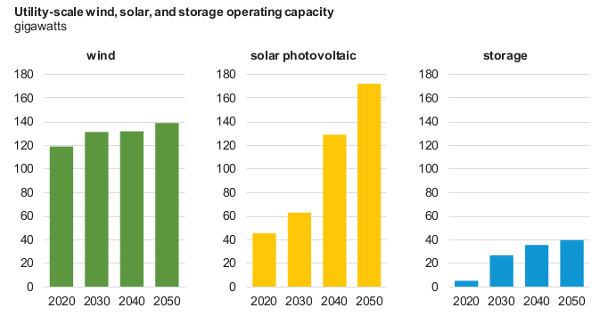The 21st century has seen multiple rapid changes in the energy landscape. Not the least of which is the meteoric growth of solar power, which has grown faster than even advocates expected.
And as this has happened analysts who study this sector have struggled to keep up with these changes, particularly in their forecasts. But the Annual Energy Outlook 2018 (AEO) released this week by the U.S. Department of Energy’s Energy Information Administration (EIA) not only fails in this regard, but envisions a limited future for solar and wind based on strange and explained assumptions that work against renewable energy.
Limited role foreseen for solar and wind
AEO 2018 both proscribes a prominent role to renewables in the future, and additionally makes several notes about how it has improved its modeling of wind and solar. But even while EIA expects solar to have the fastest growth rate through 2050, it also predicts a leveling off between 2020 and 2030, with virtually no solar built in the first half of the decade.

For reference, GTM Research – which conducts more comprehensive research on solar installations than any U.S. government agency – estimates that the United States installed an estimated 11.8 GW of solar in 2017 and expects at least 10 GW each year through 2020.
Rice University Professor Daniel Cohan, whose work spans air, climate and energy issues, took to Twitter to comment on this and other strange assumptions. This includes noting that AEO 2018 also assumes virtually no new wind after the expiration of the Production Tax Credit in the early 2020s.
A big part of the problem may be EIA’s cost estimates. AEO 2018 is estimating a cost of $2.00 per watt-AC for utility-scale solar with tracking, and $1.76/W-AC for fixed-tilt. Even accounting for the AC-DC difference and a roughly $0.10 per watt increase due to tariffs, these numbers do not square with National Renewable Energy Laboratories (NREL) estimates that average system costs were $1.11 per watt-DC for tracking systems and $1.03/watt-DC in 2017.
Cohan says that this not the first time that AEO has clearly overestimated prices for wind and solar. “Sister agencies are going out and reporting on what prices actually are,” Cohan told pv magazine, referring to the position of NREL within the Energy Department’s network of national laboratories. “To get the price of renewables so consistently overestimated from facts on the ground… that’s just inexcusable.”
Projections, predictions and excuses for bad assumptions
Perhaps due to widespread criticism of the divergence between its past outlooks and what has actually transpired, EIA notes prominently at the beginning of the report that its “projections” are not “predictions” of what will happen, but rather “modeled projections of what may happen given certain assumptions and methodologies.”
The agency particularly notes that its modeling is based only on existing policies, not any new policies that may come into play. However, such a statement does not address many of the criticisms that have been leveled at EIA’s outlooks.
“All of the errors that I have been pointing out in these reports are problems even if policies never change,” notes Professor Cohan. Among these, the report predicts that the capacity of coal plants stays steady after 2020 – despite U.S. utilities turning sharply away from coal in their plans.
“The assumption that coal plants will only close by 2050 if they have announced to close by 2017… that’s just ignoring reality,” explains an exasperated Cohan. He notes that this assumption and EIA’s extremely conservative forecasts for electric vehicles envision circumstances under which there would be little demand for additional generation.
Real-world consequences
Cohan notes that this is far from the first forecast that has downplayed renewable energy and emphasized fossil fuels, which he describes as a “persistent bias”. And he notes that this has consequences, as many policymakers, industry and journalists see EIA as the most credible source to forecast the future.
“No matter how many times they caveat that these are not forecasts, they are perceived to be forecasts by the vast majority of the people who do not understand these flaws,” notes Cohan.
He also argues that there is an element of self-fulfilling prophecies in these forecasts. “These aren’t just esoteric academic exercises – the predictions being made influence policy and influence business decisions.”
This content is protected by copyright and may not be reused. If you want to cooperate with us and would like to reuse some of our content, please contact: editors@pv-magazine.com.









By submitting this form you agree to pv magazine using your data for the purposes of publishing your comment.
Your personal data will only be disclosed or otherwise transmitted to third parties for the purposes of spam filtering or if this is necessary for technical maintenance of the website. Any other transfer to third parties will not take place unless this is justified on the basis of applicable data protection regulations or if pv magazine is legally obliged to do so.
You may revoke this consent at any time with effect for the future, in which case your personal data will be deleted immediately. Otherwise, your data will be deleted if pv magazine has processed your request or the purpose of data storage is fulfilled.
Further information on data privacy can be found in our Data Protection Policy.